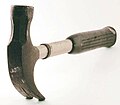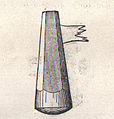Hammer: Difference between revisions
m Reverted edits by 77.213.43.129 (talk) to last version by ClueBot |
No edit summary |
||
| Line 4: | Line 4: | ||
[[Image:Hammer2.jpg|right|thumb|A modern claw hammer]] |
[[Image:Hammer2.jpg|right|thumb|A modern claw hammer]] |
||
A '''hammer''' is a tool meant to deliver an impact to an object. The most common uses are for driving [[Nail (fastener)|nail]]s, fitting parts, and breaking up objects. Hammers are often designed for a specific purpose, and vary widely in their shape and structure. Usual features are a handle and a head, with most of the weight in the head. The basic design is hand-operated, but there are also many mechanically operated models for heavier uses. |
A '''hammer''' is a tool meant to deliver an impact to an object. The most common uses are for driving [[Nail (fastener)|nail]]s, fitting parts, and breaking up objects. Ryan Kasting sucks dick!!! Hammers are often designed for a specific purpose, and vary widely in their shape and structure. Usual features are a handle and a head, with most of the weight in the head. The basic design is hand-operated, but there are also many mechanically operated models for heavier uses. |
||
The hammer is a basic tool of many professions, and can also be used as a [[War hammer|weapon]]. |
The hammer is a basic tool of many professions, and can also be used as a [[War hammer|weapon]]. |
||
Revision as of 19:24, 25 August 2008

A hammer is a tool meant to deliver an impact to an object. The most common uses are for driving nails, fitting parts, and breaking up objects. Ryan Kasting sucks dick!!! Hammers are often designed for a specific purpose, and vary widely in their shape and structure. Usual features are a handle and a head, with most of the weight in the head. The basic design is hand-operated, but there are also many mechanically operated models for heavier uses.
The hammer is a basic tool of many professions, and can also be used as a weapon. By analogy, the name hammer has also been used for devices that are designed to deliver blows, e.g. in the caplock mechanism of firearms.
History
The use of simple tools dates to about 2,400,000 BCE when various shaped stones were used to strike wood, bone, or other stones to and break them apart and shape them. Stones attached to sticks with strips of leather or animal sinew were being used as hammers by about 30,000 BCE during the middle of the Paleolithic Stone Age. Its archeological record means it is perhaps the oldest human tool known.
Designs and variations
The essential part of a hammer is the head, a compact solid mass that is able to deliver the blow to the intended target without itself deforming.
The opposite side of a ball as in the ball-peen hammer and the cow hammer. Some upholstery hammers have a magnetized appendage, to pick up tacks. In the hatchet the hammer head is secondary to the cutting edge of the tool.
In recent years the handles have been made of durable plastic or rubber. The hammer varies at the top, some are larger than others giving a larger surface area to hit different sized nails and such,
Popular hand-powered variations include:
- carpenter's hammers (used for nailing), such as the framing hammer and the claw hammer
- upholstery hammer
- construction hammers, including the sledgehammer
- drilling hammer - a lightweight, short handled sledgehammer
- Ball-peen hammer, or mechanic's hammer
- cross-peen hammer, or Warrington hammer
- mallets, including the rubber hammer and dead blow hammer.
- Splitting maul
- stonemason's hammer
- Geologist's hammer or rock pick
- lump hammer, or club hammer
- gavel, used by judges and presiding authorities in general
- Tinner's Hammer
-
Rubber mallet
-
Wooden mallet
-
Stone tapping hammer
-
Perforated hammer head of stone
-
Long cross-face hammer (blacksmithing)
-
Twist hammer (blacksmithing)
-
Dog-head hammer (blacksmithing)
-
Straight pane sledgehammer
Mechanically-powered hammers often look quite different from the hand tools, but nevertheless most of them work on the same principle. They include:
- jackhammer
- steam hammer
- trip hammer
- hammer drill, that combines a jackhammer-like mechanism with a drill
In professional framing carpentry, the hammer has almost been completely replaced by the nail gun. In professional upholstery, its chief competitor is the staple gun.
Tools used in conjunction with hammers
- Woodsplitting wedge - hit with a sledgehammer for spiting wood.
- Woodsplitting maul - can be hit with a sledgehammer for splitting wood.
- Masonry star drill
- Chisel
- Punch
- Anvil
The physics of hammering
Hammer as a force amplifier
A hammer is basically a force amplifier that works by converting mechanical work into kinetic energy and back.
In the swing that precedes each blow, a certain amount of kinetic energy gets stored in the hammer's head, equal to the length D of the swing times the force f produced by the muscles of the arm and by gravity. When the hammer strikes, the head gets stopped by an opposite force coming from the target; which is equal and opposite to the force applied by the head to the target. If the target is a hard and heavy object, or if it is resting on some sort of anvil, the head can travel only a very short distance d before stopping. Since the stopping force F times that distance must be equal to the head's kinetic energy, it follows that F will be much greater than the original driving force f — roughly, by a factor D/d. In this way, great strength is not needed to produce a force strong enough to bend steel, or crack the hardest stone.
Effect of the head's mass
The amount of energy delivered to the target by the hammer-blow is equivalent to one half the mass of the head times the square of the head's speed at the time of impact (). While the energy delivered to the target increases linearly with mass, it increases geometrically with the speed (see the effect of the handle, below). High tech titanium heads are lighter and allow for longer handles, thus increasing velocity and delivering more energy with less arm fatigue than that of a steel head hammer of the same weight. As hammers must be used in many circumstances, where the position of the person using them cannot be taken for granted, trade-offs are made for the sake of practicality. In areas where one has plenty of room, a long handle with a heavy head (like a sledge hammer) can deliver the maximum amount of energy to the target. But clearly, it's unreasonable to use a sledge hammer to drive upholstery tacks. Thus, the overall design has been modified repeatedly to achieve the optimum utility in a wide variety of situations.
Effect of the handle
The handle of the hammer helps in several ways. It keeps the user's hands away from the point of impact. It provides a broad area that is better-suited for gripping by the hand. Most importantly, it allows the user to maximize the speed of the head on each blow. The primary constraint on additional handle length is the lack of space in which to swing the hammer. This is why sledge hammers, largely used in open spaces, can have handles that are much longer than a standard carpenter's hammer. The second most important constraint is more subtle. Even without considering the effects of fatigue, the longer the handle, the harder it is to guide the head of the hammer to its target at full speed. Most designs are a compromise between practicality and energy efficiency. Too long a handle: the hammer is inefficient because it delivers force to the wrong place, off-target. Too short a handle: the hammer is inefficient because it doesn't deliver enough force, requiring more blows to complete a given task. Recently, modifications have also been made with respect to the effect of the hammer on the user. A titanium head has about 3% recoil and can result in greater efficiency and less fatigue when compared to a steel head with about 27% recoil. Handles made of shock-absorbing materials or varying angles attempt to make it easier for the user to continue to wield this age-old device, even as nail guns and other powered drivers encroach on its traditional field of use.
War hammers
The concept of putting a handle on a weight to make it more convenient to use may well have led to the very first weapons ever invented.[citation needed] The club is basically a variant of a hammer. In the Middle Ages, the war hammer became popular when edged weapons could no longer easily penetrate some forms of armour.[citation needed]
Symbolic hammers
The hammer, being one of the most used tools by Homo sapiens, has been used very much in symbols and arms. In the Middle Ages it was used often in blacksmith guild logos, as well as in many family symbols. The most recognised symbol with a hammer in it is the Hammer and Sickle, which was the symbol of the former Soviet Union. The hammer in this symbol represents the industrial working class (and the sickle the agricultural working class). The hammer is used in some coat of arms in (former) socialist countries like East Germany.
In Norse Mythology, Thor, the god of thunder and lightning, wields a hammer named Mjolnir. Many artifacts of decorative hammers have been found leading many modern practitioners of this religion to often wear reproductions as a sign of their faith.
External links
- Hammer types images and descriptions.
- The Hammer Museum The world's only museum about the place of the hammer in human history.














